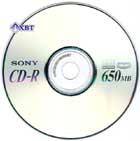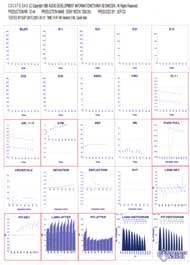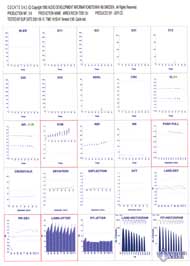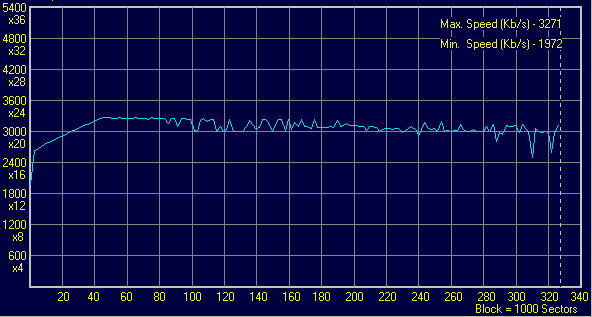 |
||
|
||
| ||
Ricoh turned to be the first company to start delivering CD-RW drives with speeds higher than usual 16/10/40. While the majority expected some advanced steps from high-efficient recorders based on the Sanyo pickup and the revolutionary technology BURN-Proof, Ricoh had its own solid pickup. Usage of their own technology JustLink which is equivalent to the BURN-Proof proves that the company follows its own way. The Ricoh's solution sometimes performs better. JustLink has a finer approach to the issue of breaking and restart of recording in case of absence of data in the buffer. A gap at the interfaces between the interuption and starting-up of recording is much less in case of the JustLink as compared with the BURN-Proof. Another interesting technology is JustSpeed, first used exactly in the MP7200A. The idea is that a disc is first tested for an optimal speed before being recorded. This procedure is carried out in three stages:
According to the Ricoh engineers the JustSpeed technology will help you to exclude a possibility of poor quality records or even damage of the disc because of too high record speed. The recording method has also changed. Ricoh has taken the Zone-CLV method, when a disc is divided into three parts: they are burnt at different speeds starting from 12X, then goes 16X, and at last 20x. The time to come to the next level depends on whether the JustSpeed technology is enabled or disabled. We managed to put our hands on a sample with a prerelease version of the microprogram. At the time of testing high-speed (higher than 16X) discs were also unavailable. That is why some errors and bugs can be fixed in new firmware versions, or they have already been fixed in the models which are selling now. As soon as we get a "mass" model, we will update this material. The testing method has undergone some changes. We had to refuse CD-R Philips Silver Premium discs since they are over ;-) It is a problem to purchase them since the majority of Philips Silver discs lying on the shelves are from Mitsui. ATIP: 97m 27s 56f The TDK Reflex from TY, as well as the Sony with the HP are also rare on the market. That is why we have chosen the Sony CDQ-74N1 discs as the most closest to our previous samples.    The recorder is, as usual, described on a separate page. Test resultsCDWinBench 99 CD-ROM Transfer RateTo compare the performance in reading operations we have taken the Plextor PX-W1610A and Yamaha CRW2100E models apart from the CD-ROM Teac 540E.  The Ricoh recorder has shown the second result leaving behind the CD-ROM TEAC CD-540 and falling just a little behind the Plextor PX-W1610A.  In this test the MP7200A comes very close to the Plextor, leaving far behind the Yamaha CRW2100 and TEAC CD-540E. The CPU utilization was:  Despite so high results of data transfer, the CPU utilization is minimal. It is accounted for by the UltraDMA33 protocol. CDWinBench 99 CD-ROM Access Time An officially claimed average access time shows that the developers were prudent when giving such specs: the Ricoh turned to be even faster than the champion TEAC CD-540. CDWinBench 99 CPU Utilization The MP7200A is again a leader. The whole load is minimal among all CD-RW devices. Time taken for CD recordingThe Ricoh MP7200 is designed so that we encounter as less problems as possible when recording a disc. Due to lack of 20X CD-R discs on the market we tried to make the device record data on other discs at 20x. For the sake of a thorough experiment we used not only CD-R Sony and Mirex, but also TDK Ultra (16x, Taiyo Yuden), and Verbatim DataLifePlus (16x, Mitsubishi). But every time the recorder with the help of the Nero reminded that it wasn't worth doing such thing.  Despite disabling of the JustSpeed in the recorder's options, when trying to record at 20X the drive decreases the speed itself down to foolproof 16X and gives a corresponding message at the end.  But for simplicity we will consider that the data are recorded at 20x. The CloneCD (beta-version 3.0.0.11) has made an interesting proposal. When coming to the submenu of disc preparation for the recording process it automatically offers 20X burning speed.  It is interesting that if you look at the disc right after the recording, you will obviously notice parts where speeds were different. It is well noticeable on the Verbatim discs. After a while these parts become less contrast and almost indistinguishable. Recording of CD-R Sony CDQ-74N1 (cyanine, 16x rated record speed) 20X
Recording of CD-R Mirex (phthalocyanine, 12x rated record speed) 20X
That's interesting that the difference when recording cyanine and phthalocyanine discs is nearly absent. Probably the selected laser power and disc rotation speed are equal for both types. Recording of CD-R Mirex (phthalocyanine, 12x rated record speed) 12X
Recording of CD-R "noname" (cyanine, the rated record speed is unknown) 4X
It seems that Ricoh has created not only a fast-reading drive, but also a champion in a record speed in all possible modes. Time spent for full formatting of a CD-RW disc in UDF formatPhilips CD-RW 4x
Ricoh CD-RW 10x
It is difficult to say whether the Ricoh drive is recording discs faster than others, or it is the Ahead InCD that works quicker than the Roxio DirectCD. The MP7200A has a higher advantage at lower formatting speeds, while at the maximum possible speed 10X the difference between the Plextor and the Ricoh makes less than a minute. Recording of a CD-RW disc (UDF)Philips CD-RW 4x
CD-RW Ricoh 10x
The MP7200A keeps its position in the test for CD-RW recording. And again I can't say definitely what deserves praising: the software or the drive itself. I can only state that the ahead InCD + Ricoh MP7200A will save your precious time when recording CDRW discs. BLER factor of CD-R discs recorded with the Ricoh drive.
Let me remind you the Plextor results.
(for these tests we used a device described in the fifth part of our review) Now let's see what the CDCATS "thinks" about it.  Sony CDQ-74N1, 20x  Mirex, 20x  Mirex, 12x  "noname", 4x The BLERometer says that the results are rather acceptable. The results of the "noname" disc prove that not all round things with a hole in the center are CD-R discs ;-) Looking at the graphs I can say that the cyanine CD-R Sony, when recorded at high speeds, yields to the phthalocyanine Mirex. You should remember, at that, that the latter is intended for 12X. The recording quality corresponds to a very high level. The only problem you may face when working with these discs is instability or a low read speed on aging CD-ROM drives with a weak laser because of less sharp structure of pits as compared with CD-Rs recorded at lower speeds. CDTest 99The graph of reading of the Sony CDQ-74N1 (20x record speed)  The graph of reading of the Sony CDQ-74N1 (16x record speed)  The graph of reading of the Mirex (20x record speed)  The graph of reading of the Mirex (12x record speed)  The graph of reading of the "noname" disc (4x record speed)  A peculiarity of the discs recorded at 20x is instability of reading on the outer tracks. I can't understand the reason, since according to the Nero, the speed was decreased in the middle of the disc down to 16X. At the same time, the CD-R Mirex recorded at the claimed 12x speed has an ideally even graph, like that of the "noname" disc whose record speed was limited at the level of 4X. CD Speed 99 test results of the recorded CD-R Sony CDQ-74N1 discs (20X)
CD Speed 99 test results of the recorded CD-R "noname" discs.
CD Speed 99 test results of the recorded CD-R Mirex (12x) discs.
CD Speed 99 test results of the recorded CD-R Mirex discs (20x).
* The data for the CD-RW drives from Plextor and Yamaha are given for Philips Silver and Mirex discs recorded at 16x. In the most of cases the Ricoh recorder is running right after the PlexWriter. It is similar to the situation occurred with the WinBench tests. The Ricoh shows excellent access speed and quite acceptable spin up/down time. CD Quality Check test results of the CD-RW (UDF) discs recorded at 4X.
CD Quality Check test results of the CD-RW (UDF) discs recorded at 10X.
CD Quality Check test results of the recorded CD-RW (ISO) discs.
The Ricoh MP7200A is not only quick at formatiing and recording CD-RW discs, but also fast at reading them. Read speed of the recorded CD-R Sony CDQ-74N1 (20X) /CD Quality Check/
Read speed of the recorded "noname" /CD Quality Check/
Read speed of the recorded CD-R Mirex (12x) /CD Quality Check/
Read speed of the recorded CD-R Mirex (20x) /CD Quality Check/
* The data for the CD-RW drives from Plextor and Yamaha are given for Philips Silver and Mirex discs recorded at 16x. Quality of the recorded CD-R Sony CDQ-74N1 (20X) /CD-ROM Drive Analyzer/Ricoh MP7200A  TEAC CD-540E  Quality of the recorded CD-R "noname"/CD-ROM Drive Analyzer/Ricoh MP7200A  TEAC CD-540E  Quality of the recorded CD-R Mirex (12x) /CD-ROM Drive Analyzer/Ricoh MP7200A  TEAC CD-540E  Quality of the recorded CD-R Mirex (20x) /CD-ROM Drive Analyzer/Ricoh MP7200A  TEAC CD-540E  The situation is similar to that of the CDSpeed test - the graph falls a bit on outer parts of the disc recorded at 20X. Such problems do not concern CD-R discs recorded at lower speeds, their graphs are even and lack for a noticeable saw or falls. Sound track extraction from audio CDs (CDDAE 99)
* - 6.92% means that the drive extracted 6.92% of the CD with errors. The extraction speed is not record. Well, the data are extracted very accurately. But it is possible that, for example, the TDK CDRW161040 or Plextor PX-W1610A could have shown even better results at the artificially restricted speed. Sound track extraction from audio CDs (EAC 0.9 prebeta 9)
Overburn
With this drive we also used 90-minute Rostok Media discs. With the Nero Burning Rom 5.5.1.8. we obtained 91 min. 55 sec. Like in the case of the TDK CyClone, the recorded disc was successfully read on the CD-ROM TEAC 40x and Sony 48x, and the ASUS 50X and LG 48x refused to read the disc. The LG drive didn't see it at all, and the ASUS 50X gave an error at the very beginning of recording data onto the hard disc. Direct copying from recorded CDs to a hard disc Copying of the CD-R Sony CDQ-74CN1 recorded at 20X
Copying of the CD-R Mirex recorded at 12X
Copying of the CD-R "noname"
Advanced DAE Quality
The results are not that bad. The only drawback is inability to read data from the LeadIn Reading of damaged CDs"Golden" CD  Scratched disc  The MP7200A is one of the best recorders that we tested in stability and data reading. I can state that the Ricoh MP7200A will read the maximum data from a damaged disc. In our tests it has read the disc at nearly 100%! The recorder defined correctly unreadable discs but still kept on reading them. But the drive, however, stumbled over the last largest unreadable sector and then followed the usual scenario... If we haven't pressed the Reset button the disc would have been probably reading it until its death. Conclusion and summary.Having released the MP7200A, Ricoh proved to be a serious player in this game. Taking into consideration that we have got only a pre-release version, I think that the finished debugged firmware version will tell positively upon the drive. But to be a leader is always difficult. Having taken the palm from Yamaha, Ricoh probably anticipated possible problems and started to work on fixing bugs noticed by test labs and users. This is proved by the released 1.10 version that contains some fixes and enhancements and improves the overall stability both in reading and recording of CD-R and CD-RW discs. Who the MP7200A may interest today? Of course people mad about high technologies, those who need a drive not only recording 12X-16X discs very good but reading them very fast; those who prefer to buy devices for a long time (the whole potential of the device in this case will be revealed when high-speed CD-R discs appear on the market), and those who want the least CPU utilization at the highest performance level. As soon as we get a production sample of the recorder, we will examine it entirely and publish the results. Besides, you should remember that soon we can see 24X recorders from Sanyo, Plextor, TDK and others... Test programs:
Write a comment below. No registration needed!
|
Platform · Video · Multimedia · Mobile · Other || About us & Privacy policy · Twitter · Facebook Copyright © Byrds Research & Publishing, Ltd., 1997–2011. All rights reserved. |